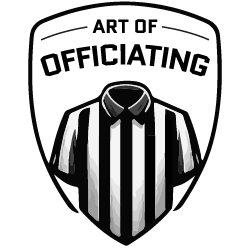Aristotle’s quote, “The whole is greater than the sum of the parts” is fitting when describing wing “connectedness.” If wings do not communicate and connect, and worse, if wings compete with each other on the field, the two independent wings will be “less than two” and the crew will not accurately manage the game. If the two wings work well with each other, the synergy will be remarkable.
Proper coordination starts during the locker room pregame
Don’t assume both wings clearly understand their responsibilities (especially if the wings are not familiar with each other). The wings must verbally review how they will communicate pre-snap, who will visually follow backs in motion, who will rule on backward/forward passes, cross-field mechanics, etc.
Pay attention to your partner across the field
Wings are typically adept at signaling if the outside receiver(s) are on the line or in the backfield, but sometimes fail to look across the line to acknowledge their partner’s signal. If both wings are punching back, the formation may be illegal. If more than four offensive players are in the backfield, both wings should sky a flag at the snap. If only one wing throws a flag, it may indicate one of the wings didn’t notice his partner’s signal or didn’t accurately count the players in the backfield. It is not a Colorado mechanic, but both wings should tap their flags in an exaggerated motion if they intend to throw a flag for an illegal formation.
In this clip, the line judge (on the near side) signals backward indicating his outside receiver is in the backfield. The player to the receiver’s left is 1 yard farther back, so he is also in the backfield. There are two receivers on the left side of the formation, and they both go downfield at the snap, so the linesman has one of the two in the backfield (it’s uncertain from the camera angle). Only the line judge throws a flag for an illegal formation (five in the backfield). Both wing officials should sky a flag on this play. As a bonus, note the right guard. He appears to be illegally in the backfield, attempting to gain a slight advantage prior to pulling to the left side.
When both wings have a flag pre-snap
When both wings sky their flags and kill the clock, they need to hustle to the middle of the field to discuss their flags before reporting a foul to the referee. Basketball officials dread the block/charge (aka “blarge”) mistake when one official signals “block” while the other official simultaneously signals “charge.” The same disconnect can happen if both wings throw a pre-snap flag and then immediately signal different fouls to the referee without first checking with each other.
Forward or backward pass?
On quick passes to the flank, the wing that observes the pass going away will rule if the pass was forward or backward. If that wing is visually blocked, the other wing should make the ruling. With Colorado mechanics, neither wing should punch back to indicate the pass was backward. If one wing punches back and the other wing indicates the pass is forward and incomplete, we have an awkward disconnect.
Marking forward progress
The wings must be in sync with each other and end up on the same yard line. Note I didn’t say the wings must square off on the same yard line because sometimes the wings will not initially mark the same line. Unless the ball is downed at the center of the field, one wing will be the covering official. The other official must concede the spot and not insist on keeping his spot. So in most cases, the wing who is not the covering official should adjust and subtly move to his partner’s spot.
If wings disagree on forward progress
There is an important exception to this mechanic. If one wing clearly observes the runner was downed short of where his partner is marking, or if the covering official fails to properly indicate forward progress (often on a pass play where a receiver catches a pass and is immediately contacted and driven backward), the opposite wing must crash and sell the correct spot (“Forward progress here! Runner was downed here!”).
When the ball is downed along the far sideline
The opposite wing does not have to square off to mark the forward progress spot. In fact, he will probably not have a good idea where the ball was dead by rule. It’s okay for the opposite wing to banana slightly onto the field before mirroring the covering wing’s spot and moving to the numbers.
When only a few seconds remain in either half
If the play ends close to the sideline, it’s extremely important to communicate to both coaches when the clock will start. Will the clock start on the snap because the runner went OOB or will it start on the R’s silent wind because the runner was downed inbounds near the sideline beyond the LTG? The covering wing MUST communicate when the clock will start to the opposite wing so the coach on that sideline can appropriately respond. The R will typically facilitate passing this information.
Cross-field mechanic
Sometimes a wing may need his/her partner to help with the forward progress spot. We call that a “cross-field mechanic.” There are many reasons this may happen. The wings need to trust each other and not compete to mark forward progress. Sometimes a wing’s vision of the ball may be blocked. If a wing is not confident in the spot, he can tell the umpire to take the other wing’s spot (if the yard line is different).

